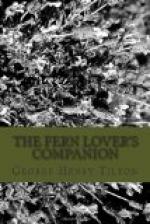[Illustration: Powdery Cloak Fern. Notholaena dealbata (Kansas) (G.E. Davenport)]
[Illustration: The Common Chain Fern. Woodwardia virginica]
(1) THE COMMON CHAIN FERN. Woodwardia virginica
Sterile and fertile fronds similar in outline, two to four feet high, once pinnate, the pinnae deeply incised with oblong segments. Fruit-dots oblong in chain-like rows along the midrib both of the pinnae and the lobes, confluent when ripe. Veins forming narrow rows of net-like spaces (areoles) beneath the fruit-dots, thence free to the margin. The spores ripen in July.
The sterile fronds resemble those of the cinnamon fern, but the latter grow in crowns, with a single frond in the center, while the fronds of the chain fern rise singly from the creeping rootstock, which sends them up at intervals all summer. The sori are borne on the backs of fertile fronds. There are usually more sterile than fertile blades, especially in dense shade. We have waded repeatedly through a miry swamp in Melrose, Mass., where the wild calla flourishes along with the blueberry and other swamp bushes, and have found the chain fern in several shaded spots, but every frond was sterile. It is said that when exposed to the sun it always faces the south. Swamps, Maine to Florida, especially along the Atlantic Coast, and often in company with the narrow-leaved species.
[Illustration: Net-Veined Chain Fern. Woodwardia areolata (Stratford, Conn.)]
(2) NET-VEINED CHAIN FERN
NARROW-LEAVED CHAIN FERN
Woodwardia areolata. W. angustifolia
Root stocks creeping and chaffy. Sterile and fertile fronds unlike; sterile ones nine to twelve inches tall, deltoid-ovate. Broadest at the base, with lanceolate, serrulate divisions united by a broad wing. Veins areolate; fertile fronds taller, twelve to twenty inches high with narrowly linear divisions, the areoles and fruit-dots in a single row each side of the secondary midrib, the latter sunk in the tissues.
This species is less common than the Virginia fern, but they often grow near each other. We have collected both in the Blue Hill reservation near Boston, and both have been found in Hingham, Medford, and Reading, and doubtless in other towns along the coast. Mrs. Parsons speaks of finding them in the flat, sandy country near Buzzard’s Bay. The net-veined species has some resemblance to the sensitive fern, but in the latter the spore cases are shut up in small pods formed by the contracting and rolling up of the lobes, whereas the chain fern bears its sori on the under side of long, narrow pinnae. Besides, the sterile fronds of the latter have serrulate segments. As in the sensitive fern there are many curious gradations between the fertile and sterile fronds, both in shape and fruitfulness. Waters calls them the “obtusilobata form.”




